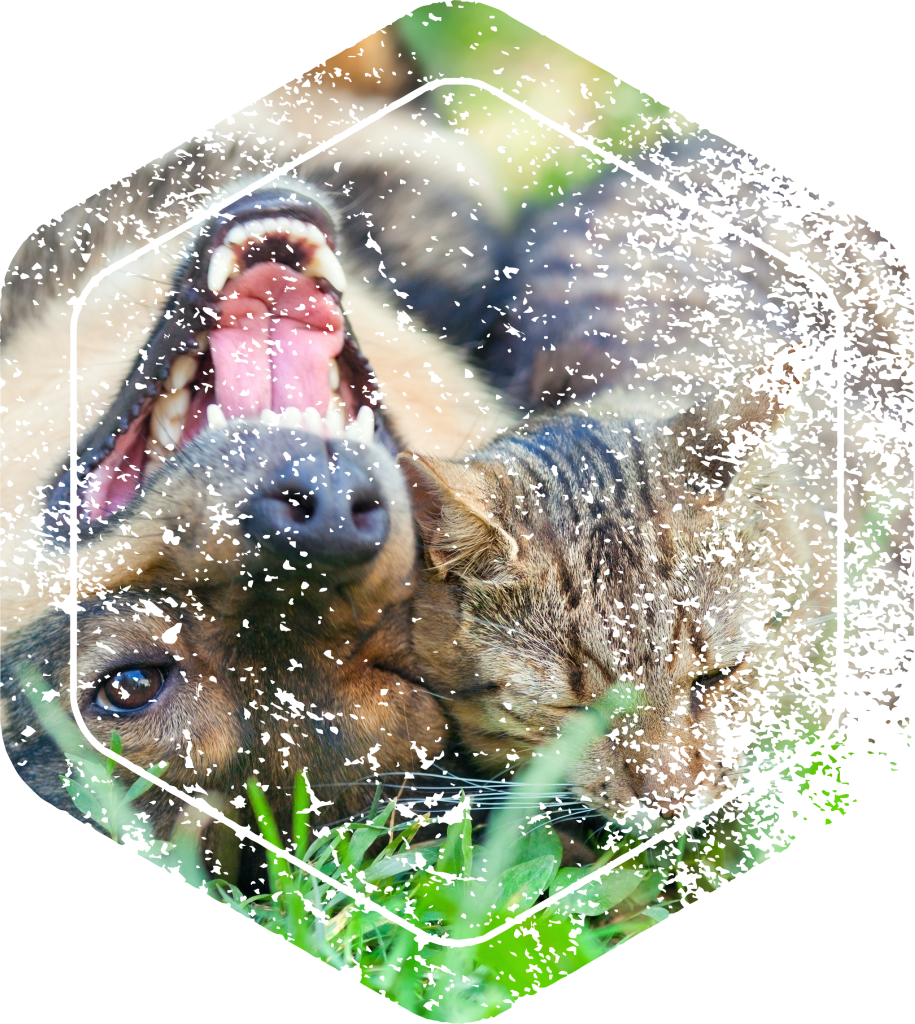Have you heard about the benefits of raw feeding, but you’re not sure where to start? Have you been given conflicting information about the risks and rewards of raw feeding? Are you overwhelmed by all the different options of commercial raw foods? Do you know lots about raw feeding, and want to find a vet who understands about nutrition and actively supports owner choices? Are you a curious sceptic, who thinks raw feeding is a fad? If so, our #rawfood information is especially for you!
In this opening series of articles we will discuss pros and cons, explain different types of raw feeding, and deep-dive into some research. If you have any particular questions you think would be good for us to answer, let us know: [email protected]
Why feed raw?
Is there really any benefit to feeding our cats and dogs raw or freshly cooked foods? We are becoming more aware of the benefits of fresh whole foods for human health and it makes sense that we want the same benefits for our four-legged family. Here I discuss some of the good reasons to consider feeding fresh, and why you might also decide to stick to kibble.
Individualisation
One of my favourite things about raw or home-cooked feeding is the ability to make bespoke recipes that are perfect for the individual pet. If they have any health issues, there is the opportunity to optimise nutrition for their benefit. This is especially important for dogs and cats with allergies and other conditions.
Digestibility
Fresh raw or cooked foods have a higher digestibility than kibble. This results in lower poo volume (a great benefit!), and is beneficial in pets with digestive issues such as malabsorption, IBD, allergies. If your cat or dog is fussy with food, they don’t have to eat as much as they do with kibble to maintain perfect body condition.
Water content
This is a bit of a weird one, and obvious if you think about it, but fresh food contains much more water than dry kibble. For most pets, this doesn’t make a huge difference, but with certain health conditions, for example, urinary issues, this has a significant positive impact.
Palatability
Fresh food tastes good! Of course, there are always exceptions (cats, I’m talking about you!), but in general pets much prefer their fresh food meals. It can be really satisfying to give food that you know your pet absolutely loves.
Ethics and sustainability
Sustainability is one of our core values at The Wellness Clinic, and pet food is an area where improvements can be made. Many of us are moving towards buying locally-reared meat, organic meat, and meat with specific welfare requirements such as Freedom Foods or free range. We can also use seasonal, locally-grown vegetables. This reduces air miles, improves welfare, and supports the local community. The minimal processing involved in fresh feeding, especially DIY, has much less impact on our environment than factory-made ultra-processed foods like kibble.
Nutrient damage
The high-heating process (extrusion) causes the degradation of many nutrients – including denaturing proteins and vitamin loss. Although many of these are added again, it isn’t clear what effect this processing may result in.
Supplement type
Because of this loss of vitamins and minerals, and to abide by AAFCO standards, artificial supplements must be added to kibble to ensure it is balanced. However, not all supplements are equal. Chelated and picolinates are great choices but expensive and therefore commercially viable in kibble production. Sulfates/chloride are better than carbonates, which are better than oxides. Zinc oxide, for example, is much more difficult to absorb but is much more cost-effective than other zinc supplements, so is frequently used in kibble. In most raw or home-cooked diets, supplements are necessary for nutritional balance, however we can choose the most effective rather than the cheapest for our pets.
Heating reactions (MRPs & AGEs)
The extrusion process of creating kibble promotes a non-enzymatic reaction between proteins and sugars called a Maillard reaction. This results in Maillard reaction products (MRPs) and advanced Maillard reaction products (AGEs). This is an important concern since, in human medicine, MRPs/AGEs have been shown to contribute to increasing prevalence of diet-related chronic inflammatory states in the gut with negative health consequences and performance. The consequence of MRPs and AGEs in animal food are less clear, but in theory they could have the same significance for cat and dog health. Fresh food does not contain MRPs or AGEs. If you prefer to feed kibble but want to avoid MRPs and AGEs, you can use cold-pressed kibble which doesn’t undergo the Maillard reaction.
Teeth
There is no scientific research that supports this, but the experience of hundreds of raw-feeding dog and cat owners is that the pets who eat raw meaty bones have a much lower incidence of dental disease.
These sound like some great advantages! Surely everyone should feed fresh? Or are there any good reasons not to feed raw?
Cost (money and time)
Fresh food is not the cheap and easy option. There are a variety of commercially available raw and fresh foods available, at a variety of price points, but generally speaking the cost is more for a balanced fresh diet in comparison to kibble. If you want to take advantage of some of the best bits of fresh feeding – making meals that are suited perfectly to your individual pet – this means you are going to have to source and prepare the ingredients yourself (after getting a recipe from a nutritionist, such as the TWC vets). This takes a lot of time, organisation and energy, which we don’t all have!
Storage
Have you got a giant freezer? Because you need one if you are going to raw or fresh feed! Correct storage is really important for safe food hygiene (see below). This generally means freezing batches and defrosting in the refrigerator as required. Even if you made up the meals each day, your ingredients would need a lot of fridge/freezer room. If your home is short of space, you spend a lot of time travelling, or have intermittent/unreliable electricity, then raw and fresh cooked food may be impractical for you.
Bacterial and parasite risk
This is the disadvantage that gains the most attention from veterinary professionals. Research tells us that cats and dogs who eat raw meat will shed a greater number of bacteria in their stool and on their coat, potentially a higher proportion of pathogenic (disease-causing) bacteria such as Salmonella, and potentially more bacteria that are resistant to multiple antibiotics. If our pets are shedding high numbers of bacteria there is risk to human health, as areas of the house can become contaminated (for example if your pets sleep on your bed, or share your plates), and risk from pets licking our hands and face. For this reason, if members of the household are immunocompromised or there are young children in the family, raw feeding may not be the best choice. Luckily, these risks are eliminated by cooking meat first, so it is still possible to feed fresh foods without the bacterial risk.
Good hygiene practices in the kitchen are necessary to reduce bacterial risk. Defrosting meat in the refrigerator rather than on the counter, careful washing of bowls, not cross-contaminating other kitchen items, and thorough hand washing are all things we should do when preparing our own meat, as well as our pets. One thing to note is that if you buy your dog recreational bones (like knuckle bones) which may last some time, there is a higher risk of bacterial growth and contamination. Many owners choose to restrict recreational bones to the garden or a crate only to try and limit contamination around the house.
There is also an increased risk of our pets contracting various parasites when eating raw meat, some of which can pose a serious health risk to them or to humans. Some parasites, such as the protozoa Neospora caninum, Toxoplasma gondii, and Sarcocystis species are inactivated by freezing at -20C for 1-2 days. Freezing eliminates risk of these being transmitted to animals, humans, ir the environment.
Roundworms, particularly Toxacara species, can be ingested in raw meat (particularly poultry, rodents, and rabbits, but also potentially sheep, cattle and pigs) as the larvae may be found in muscle meat. They complete their life cycle within the dog (T.canis) or cat (T.cati), resulting in potential gastrointestinal disease and environmental contamination. It is also important to wash raw vegetables, as this is a potential source of contamination.
Tapeworm is also a potential risk to animal and human health. Echinococcus multilocularis is a particular public health risk, but is not present in the UK. Neither is Echinococcus granulosus (excluding Wales). Various Tenia species are found in the UK, in rodents, rabbits/hares, sheep, goats, cattle and pigs. They can be detected as cysts in the muscle during the slaughtering and meat inspection process, therefore our pets are at higher risk if they hunt and catch prey rather than eat raw meat prepared commercially. It therefore is paramount to pay attention to where your raw food originates from.
Some of these parasites sound, and can be, a bit scary. It is therefore important to monitor for them regularly using faecal worm egg counts, or treat with a deworming product. It is also vital to bag and dispose of dog poo properly to reduce potential environmental contamination.
Nutritional balance
This is by far the most common issue I see with raw fed pets and those on home cooked diets. Unfortunately there is a lot of misinformation about feeding our pets, and the internet is full of people giving advice on ratio diets (see a later article as to why these are not appropriate!), quick fixes, and worst of all there are many, many companies producing raw food commercially that say they are balanced when they are not. Some nutritional imbalances can be very fast and dramatic – for instance I have seen a small dog eating a commercially available food containing lung and trachea developed nutritional hyperthyroidism, and an owner try to do a DIY recipe for her cats resulting in one youngster coming in as an emergency having seizures due to dangerously low blood calcium levels. However the vast majority of dietary imbalances take months, or even years, to reveal themselves. Commonly I see skin issues (often due to low zinc and vitamin E), digestive problems (often to do with high fat and low vitamin B), musculoskeletal issues like poor growth, arthritis, ligament damage (from improper calcium:phosphorus ratio and/or low vitamin D). Because these conditions only appear many months after changing their food, it can take a really long time to work out what’s going on as it isn’t obviously related to what the pet is eating.
Tooth fracture and intestinal blockage
Despite there being lots of experience suggesting bones can improve dental health (above), there is a definite risk of tooth fracture when feeding raw meaty bones. As any dental specialist will tell you, if your dog is chewing something that you can’t easily indent by pressing your thumbnail into, there is a risk of tooth fracture. Although this is something to consider, if I think about the number of dogs who regularly have chews, toys, and bones that fit this risk profile and also consider the number of tooth fractures I see in practice, I consider the risk to be fairly low.
Bones (either as entire bone chewed up or as bonemeal) can cause constipation or intestinal blockage. I often see constipation where owners have been feeding cheaper commercially-prepared poultry-based raw foods, which often contain far too much bone. If bones or bone-meal aren’t first introduced slowly, this can also happen. Intestinal obstruction usually occurs if your dog (usually dogs rather than cats) is a “gulper”. If they have any resource-guarding tendencies, or like to swallow-first-chew-never (classically bull terrier breeds, but potentially others, too), then feeding bones may not be safe for that individual.
Correct choice of bone and choice of individual pet are vital to avoid bone-related issues. Bones for eating should never be weight-bearing bones – only feed things like necks and wings – and they should never be cooked. Larger bones for recreation (chewing) should be big enough that they can’t break into big chunks – knuckle bones are perfect. It is also possible to feed a nutritionally balanced raw food diet without any bones at all (using a calcium supplement).
In conclusion, there are lots of good reasons why you might choose to feed your cat or dog raw food, and equally there are good reasons not to. The most important thing is that you feel empowered to decide the best way of feeding your pet based on their, and your, individual circumstances and preferences.
Here at The Veterinary Wellness Centre we are passionate about supporting you to find the right nutrition for your cats and dogs. Perfect looks different for every single pet! Contact us if you would like some support in finding what works for you: [email protected]





































